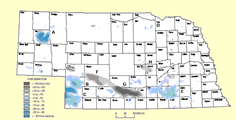Natural Resources, School of

Conservation and Survey Division: Faculty and Staff Publications
Document Type
Article
Date of this Version
7-20-2016
Citation
2016 The Authors. Sedimentology
2016 International Association of Sedimentologists
Abstract
Buried valleys are characteristic features of glaciated landscapes, and their deposits host important aquifers worldwide. Understanding the stratigraphic architecture of these deposits is essential for protecting groundwater and interpreting sedimentary processes in subglacial and ice-marginal environments. The relationships between depositional architecture, topography and hydrostratigraphy in dissected, pre-Illinoian till sheets is poorly understood. Boreholes alone are inadequate to characterize the complex geology of buried valleys, but airborne electromagnetic surveys have proven useful for this purpose. A key question is whether the sedimentary architecture of buried valleys can be interpreted from airborne electromagnetic profiles. This study employs airborne electromagnetic resistivity profiles to interpret the threedimensional sedimentary architecture of cross-cutting buried valleys in a ca 400 km2 area along the western margin of Laurentide glaciation in North America. A progenitor bedrock valley is succeeded by at least five generations of tunnel valleys that become progressively younger northward. Tunnel-valley infills are highly variable, reflecting under-filled and over-filled conditions. Under-filled tunnel valleys are expressed on the modern landscape and contain fine sediments that act as hydraulic barriers. Over-filled tunnel valleys are not recognized in the modern landscape, but where they are present they form hydraulic windows between deep aquifer units and the land surface. The interpretation of tunnel-valley genesis herein provides evidence of the relationships between depositional processes and glacial landforms in a dissected, pre-Illinoian till sheet, and contributes to the understanding of the complex physical hydrology of glacial aquifers in general.
Included in
Geology Commons, Geomorphology Commons, Hydrology Commons, Paleontology Commons, Sedimentology Commons, Soil Science Commons, Stratigraphy Commons


Comments
Sedimentology (2017) 64, 553–581 doi: 10.1111/sed.12314